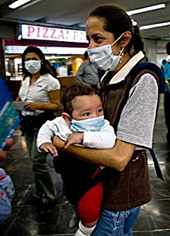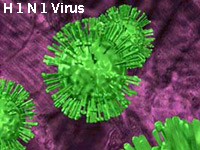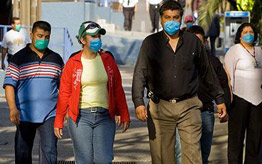Duncan MacDonald
Jakarta 29 April 2009
Reviewed 18 February 2022
The World Health Organisation (WHO) has said that the most recent research on swine flu has shown  that the virus is not caused by pigs. Note: see box below. The disease is now being referred to as Mexican flu or "2009 H1N1 flu". The WHO moved the pandemic alert from four to five, the second highest. The first case of what was called swine flu was reported in Mexico and its first fatality was confirmed there on 30-April-2009
that the virus is not caused by pigs. Note: see box below. The disease is now being referred to as Mexican flu or "2009 H1N1 flu". The WHO moved the pandemic alert from four to five, the second highest. The first case of what was called swine flu was reported in Mexico and its first fatality was confirmed there on 30-April-2009
The 23 month-old infant who died in Texas USA, in the first fatal case from the swine flu outbreak in the United Sates, was also Mexican. The child came from Mexico to Houston for medical treatment [ 1 ]
The number of fatalities and people sickened by the virus continues to rise. No doubt by the time you read this article the numbers will have increased. As at 1-May-2009 the following figures were available;
Mexico: 160 deaths, 2,498 sick but only 1,311 suspected swine flu patients remained hospitalised. Daily admissions in Mexico's public hospitals suggest the outbreak may have peaked
By 9 March, the first symptoms were showing up in the Mexican state of Veracruz, where pig farming is the main industry in mountain hamlets and small clinics provide the only health care.
The earliest confirmed case was a 5 year old boy, Edgar Enrique Hernandez in La Gloria village. Edgar recovered and although he still has a persistent cough, says "I feel good." Several hundred people from the village of 2,500 people became sick and two children died, prompting authorities to fumigate the entire village
USA: 1 death, 109 confirmed cases in 11 states; Canada: 97 confirmed; New Zealand: 14 confirmed; Spain: 10 confirmed; UK: 8; Germany: 3; Israel: 2; Austria, Costa Rica, Switzerland and the Netherlands - all 1 case confirmed Some Facts & Figures Indonesia is currently screening all people arriving from overseas at its major airports for flu like symptoms. There are no reported swine flu cases in Indonesia - so far
The swine flu virus is designated H1N1 – the same H1N1 Spanish flu virus that killed between 50 million and 100 million people world-wide in 25 weeks in 1918-1919. For more details on the 1918 Spanish flu click on www.dmacDigest.com/flu1918

Indonesia of course has had experience over the past 5 years with Avian (bird) flu H5N1. During that time Indonesia has had more fatalities than any other country – 137 as at 24-Sep-08
However during that same 5 year period Indonesia has suffered approx 750,000 deaths from Tuberculosis (TB) [ 2 ]
The total number of people worldwide who die from normal flu symptoms each year is difficult to come by. However during a typical year in the United States, 30,000 to 50,000 people die as a result of influenza viral infection. Frequently cited numbers are 37,000 annually.
Estimated rates of influenza-associated pulmonary and circulatory deaths per 100,000 persons were 0.4 -0.6 among persons aged 0-49 years, 7.5 aged 50-64 years, and 98.3 among persons ages >65 years [ 3 ]
Those figures show the most vulnerable to normal flu symptoms are the elderly, while most young children are infected by the virus. Swine flu – and for that matter the 1918 Spanish flu (both H1N1 remember) are different in so far as the people most vulnerable are young adults in the prime of their life – aged 20 – 40 years
Scientists believe the immune system in children and the very elderly is weakened and cannot effectively fight the virus. The immune system of people in the prime of life, reacted, or in fact over-reacted to the virus, causing the lungs to fill with blood from ruptured blood vessels. In fact death was by drowning on one's own bodily fluids
Indonesia is stocking as many as 3 million doses of oseltamivir antiviral drugs. Enough for around 300,000 people. [ 4 ]
Australia has 8.7 million doses of Tamiflu and Relenza drugs and large stores of surgical masks [ 5 ]
Swine Flu symptoms are like regular flu symptoms – fever (38 oC or more), coughs, sore throat, body aches, headache, chills and fatigue. Some people have reported diarrhoea and vomiting
diarrhoea and vomiting
. These symptoms can be caused by many other conditions. It takes a lab test to tell whether it's Swine flu [ 6 ]  that the virus is not caused by pigs. Note: see box below. The disease is now being referred to as Mexican flu or "2009 H1N1 flu". The WHO moved the pandemic alert from four to five, the second highest. The first case of what was called swine flu was reported in Mexico and its first fatality was confirmed there on 30-April-2009
that the virus is not caused by pigs. Note: see box below. The disease is now being referred to as Mexican flu or "2009 H1N1 flu". The WHO moved the pandemic alert from four to five, the second highest. The first case of what was called swine flu was reported in Mexico and its first fatality was confirmed there on 30-April-2009The 23 month-old infant who died in Texas USA, in the first fatal case from the swine flu outbreak in the United Sates, was also Mexican. The child came from Mexico to Houston for medical treatment [ 1 ]
The number of fatalities and people sickened by the virus continues to rise. No doubt by the time you read this article the numbers will have increased. As at 1-May-2009 the following figures were available;
Mexico: 160 deaths, 2,498 sick but only 1,311 suspected swine flu patients remained hospitalised. Daily admissions in Mexico's public hospitals suggest the outbreak may have peaked

By 9 March, the first symptoms were showing up in the Mexican state of Veracruz, where pig farming is the main industry in mountain hamlets and small clinics provide the only health care.
The earliest confirmed case was a 5 year old boy, Edgar Enrique Hernandez in La Gloria village. Edgar recovered and although he still has a persistent cough, says "I feel good." Several hundred people from the village of 2,500 people became sick and two children died, prompting authorities to fumigate the entire village
USA: 1 death, 109 confirmed cases in 11 states; Canada: 97 confirmed; New Zealand: 14 confirmed; Spain: 10 confirmed; UK: 8; Germany: 3; Israel: 2; Austria, Costa Rica, Switzerland and the Netherlands - all 1 case confirmed Some Facts & Figures Indonesia is currently screening all people arriving from overseas at its major airports for flu like symptoms. There are no reported swine flu cases in Indonesia - so far
The swine flu virus is designated H1N1 – the same H1N1 Spanish flu virus that killed between 50 million and 100 million people world-wide in 25 weeks in 1918-1919. For more details on the 1918 Spanish flu click on www.dmacDigest.com/flu1918

Indonesia of course has had experience over the past 5 years with Avian (bird) flu H5N1. During that time Indonesia has had more fatalities than any other country – 137 as at 24-Sep-08
However during that same 5 year period Indonesia has suffered approx 750,000 deaths from Tuberculosis (TB) [ 2 ]
The total number of people worldwide who die from normal flu symptoms each year is difficult to come by. However during a typical year in the United States, 30,000 to 50,000 people die as a result of influenza viral infection. Frequently cited numbers are 37,000 annually.
Estimated rates of influenza-associated pulmonary and circulatory deaths per 100,000 persons were 0.4 -0.6 among persons aged 0-49 years, 7.5 aged 50-64 years, and 98.3 among persons ages >65 years [ 3 ]
Those figures show the most vulnerable to normal flu symptoms are the elderly, while most young children are infected by the virus. Swine flu – and for that matter the 1918 Spanish flu (both H1N1 remember) are different in so far as the people most vulnerable are young adults in the prime of their life – aged 20 – 40 years
Scientists believe the immune system in children and the very elderly is weakened and cannot effectively fight the virus. The immune system of people in the prime of life, reacted, or in fact over-reacted to the virus, causing the lungs to fill with blood from ruptured blood vessels. In fact death was by drowning on one's own bodily fluids
Indonesia is stocking as many as 3 million doses of oseltamivir antiviral drugs. Enough for around 300,000 people. [ 4 ]
Australia has 8.7 million doses of Tamiflu and Relenza drugs and large stores of surgical masks [ 5 ]
Swine Flu symptoms are like regular flu symptoms – fever (38 oC or more), coughs, sore throat, body aches, headache, chills and fatigue. Some people have reported
 diarrhoea and vomiting
diarrhoea and vomitingHow do I protect myself and my family ? Good hygiene is the key. You can reduce, but not eliminate, the risk of catching or spreading influence by:
- ◊ Use a tissue to cover your nose and mouth when coughing or sneezing
- ◊ Disposing of used tissues promptly and carefully
- ◊ Washing your hands frequently to reduce the spread of the virus from your hands to your face (mouth, nose and eyes), or to other people
- ◊ Touch lift buttons with your knuckles, not your finger tips
 If I have flu symptoms – what should I do ?
If I have flu symptoms – what should I do ? ♦ Stay at home and rest
♦ Take medicines such as aspirin, ibuprofen or paracetamol to relieve symptoms. Children under 16 must not be given aspirin or ready-made flu remedies containing aspirin
♦ Drink plenty of fluids
♦ Contact a doctor if you hae travelled recently to Mexico or you develop complications such as shortness of breath
Should I take an Antiviral ? Tamiflu and Relenza will not protect you against catching influenza and should not be taken unless you have symptoms. If your doctor suspects swine flu, he/she may write you a prescription for Tamiflu or Relenza. Those drugs may not be required. US swine flu patients have made a full recovery without it

Do I need a face mask ? The widespread wearing of masks during a pandemic is unlikely to be effective at preventing people from becoming infected with the virus. However they may have some limited ability to stop those already infected with the virus from spreading it
CONCLUSION:
The swine flu outbreak is receiving a lot of media attention world-wide. While there is need to be concerned, there is no reason to be alarmed at this stage. Remember WHO also raised the issue of Bird Flu which has yet to become anything like a pandemic.
"Influenza pandemics must be taken seriously precisely because of their capacity to spread rapidly to every country in the world," WHO Director General, Margaret Chan told a news conference in Geneva as she raised the official alert level to phase 5, the last step before a pandemic
"The biggest question is this: how severe will the pandemic be, especially now at the start," Chan said. But she added that the world "is better prepared for an influenza pandemic than at any time in history"
Almost all cases outside Mexico have had mild symptoms, and only a handful have required hospitalization
The 20th century had 4 Flu Pandemics 1918 Spanish flu – 50-100 million deaths- [H1N1]; 1957 Asian flu -70,000 deaths- [H2N2]; 1968 Hong Kong flu -34,000 deaths [H3N2] and 1977 Russian flu – no Nºs available [H5N1] |




